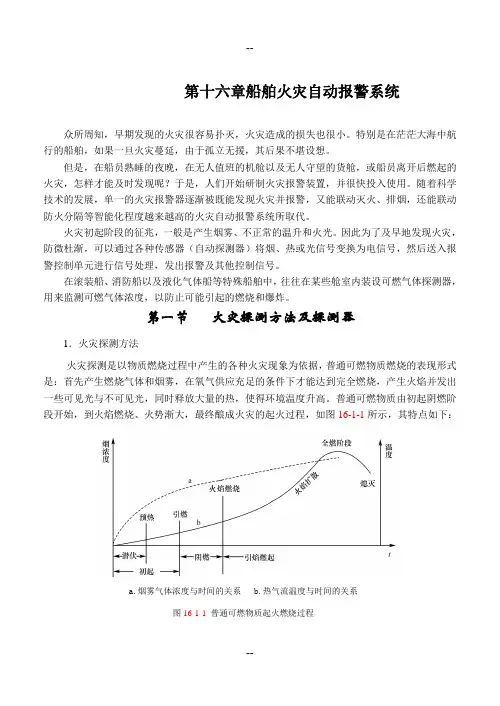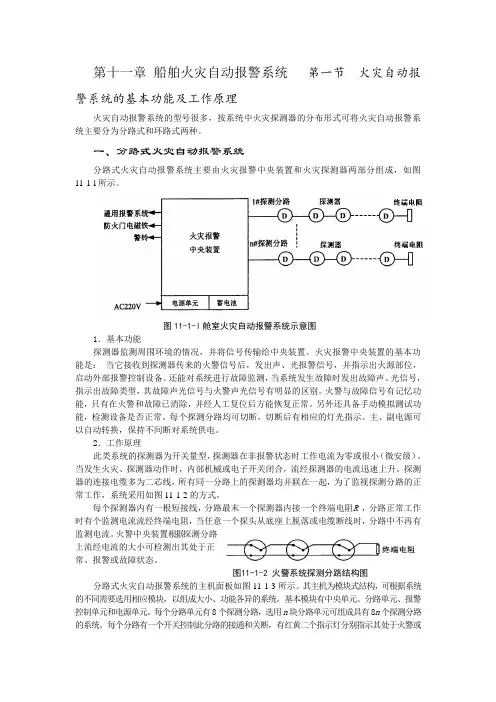船舶火灾自动报警系统讲解
- 格式:ppt
- 大小:3.78 MB
- 文档页数:37

船舶火灾报警系统的操作流程船舶火灾报警系统的操作流程一般来说,船舶是一个高度复杂的机械系统,其各个组件、设备等都需要精细的管理、维护和保养。
其中,船舶火灾报警系统是非常重要的一个安全设备,因为在海上航行中,一旦发生火灾,可能引发连锁反应,对船舶和人员的生命财产安全造成极大威胁。
因此,正确操作船舶火灾报警系统,实现及时、准确、可靠的报警是非常重要的。
一、船舶火灾报警系统的概述首先,我们需要了解一些基本概念和知识。
船舶火灾报警系统主要由烟感探头、手动报警器、声光报警器、控制面板、防火门、喷淋系统等组成。
其中,烟感探头是最关键的组件,可感应船舶各个区域的烟雾和热量,并将信息传递给控制面板。
控制面板是船舶火灾报警系统的大脑,接收烟感探头的信号,分析判断烟雾、火灾等情况,并发出相应的报警信号和指令。
手动报警器是为了避免烟感探头无法在火灾发生时发出报警信号,而设置的手动开关。
声光报警器是为了在火灾发生时及时提醒船员,让他们能够迅速采取适当的措施。
二、船舶火灾报警系统的操作流程1、启动船员需要在航行之前测试和启动船舶火灾报警系统,以保证其完好有效。
具体操作如下:(1)检查烟感探头和手动报警器是否处于正常工作状态;(2)调整声光报警器的音量,检查是否正常;(3)检查控制面板的所有指示灯是否正常亮起;(4)测试火灾报警系统的响应速度。
2、巡航在巡航过程中,船员需要随时检查船舶火灾报警系统是否正常工作。
具体操作如下:(1)定期检查烟感探头和手动报警器,确保其灵敏度和精度;(2)检查声光报警器是否正常工作,声音是否正常;(3)检查控制面板的指示灯是否正常亮起;(4)定期测试火灾报警系统的响应速度,以确保在火灾发生时能够及时报警。
3、火灾报警一旦船舶火灾报警系统发出报警信号,船员需要立即采取相应措施,以确保生命财产安全。
具体操作如下:(1)查看控制面板上的指示灯,以确定火灾发生的具体位置;(2)寻找手动报警器并使用,以确保火灾报警系统能够立即发出报警信号;(3)采取适当的灭火措施,如使用灭火器灭火、开启喷淋系统等,以控制火势和熄灭火灾;(4)疏散人员,确保船员和乘客的生命安全。


第十六章船舶火灾自动报警系统众所周知,早期发现的火灾很容易扑灭,火灾造成的损失也很小。
特别是在茫茫大海中航行的船舶,如果一旦火灾蔓延,由于孤立无援,其后果不堪设想。
但是,在船员熟睡的夜晚,在无人值班的机舱以及无人守望的货舱,或船员离开后燃起的火灾,怎样才能及时发现呢?于是,人们开始研制火灾报警装置,并很快投入使用。
随着科学技术的发展,单一的火灾报警器逐渐被既能发现火灾并报警,又能联动灭火、排烟,还能联动防火分隔等智能化程度越来越高的火灾自动报警系统所取代。
火灾初起阶段的征兆,一般是产生烟雾、不正常的温升和火光。
因此为了及早地发现火灾,防微杜渐,可以通过各种传感器(自动探测器)将烟、热或光信号变换为电信号,然后送入报警控制单元进行信号处理,发出报警及其他控制信号。
在滚装船、消防船以及液化气体船等特殊船舶中,往往在某些舱室内装设可燃气体探测器,用来监测可燃气体浓度,以防止可能引起的燃烧和爆炸。
第一节火灾探测方法及探测器1.火灾探测方法火灾探测是以物质燃烧过程中产生的各种火灾现象为依据,普通可燃物质燃烧的表现形式是:首先产生燃烧气体和烟雾,在氧气供应充足的条件下才能达到完全燃烧,产生火焰并发出一些可见光与不可见光,同时释放大量的热,使得环境温度升高。
普通可燃物质由初起阴燃阶段开始,到火焰燃烧、火势渐大,最终酿成火灾的起火过程,如图16-1-1所示,其特点如下:a.烟雾气体浓度与时间的关系b.热气流温度与时间的关系图16-1-1 普通可燃物质起火燃烧过程(1)初起和阴燃阶段占时较长普通可燃物在火灾初起和阴燃阶段尽管产生了烟雾可燃气体混合物,并且大量的烟雾可燃气体混合物可能已经充满某一空间,但是环境温度不高,火势尚未达到蔓延发展的程度。
如果在此阶段能将重要的火灾信息(烟雾浓度)有效地探测出来,就可以将火灾损失控制在最低限度。
(2)火焰燃烧阶段火势蔓延迅速普通可燃物经过足够的火灾初起和阴燃阶段后,足够的蓄积热量会使环境温度升高,并在物质的着火点温升加速,发展成火焰燃烧,形成火焰扩散,火势开始蔓延,环境温度不断升高,燃烧不断扩大,形成火灾。


船舶火灾自动报警系统图文1. 船舶安全问题的重要性船舶是海运业的重要形式,在国际贸易中扮演着至关重要的角色。
然而,随着航线不断扩大和航速的不断提高,不可避免地会面临一些安全隐患。
其中最为重要的安全隐患是船舶火灾。
自20世纪初,关于船舶火灾的报告已经层出不穷。
每年都有数百艘船舶发生火灾事故,由此造成了生命和财产的严重损失。
如果没有适当的安全装置来应对此类事件,这些火灾很可能会导致更多的人员伤亡和船舶损坏。
因此,船舶火灾自动报警系统的推广和应用至关重要。
2. 火灾自动报警系统的基本原理船舶火灾自动报警系统是一种专门为船舶设计的安全装置,能够快速响应火灾事件,并通知船员及乘客要求及时撤离。
它的设计原理主要包括三个步骤:火灾检测、信号传输和报警响应。
2.1 火灾检测船舶火灾自动报警系统的第一步是火灾检测。
它使用一系列火灾检测传感器,这些传感器能够监测船舶内部及外部的温度和烟雾情况。
当传感器检测到温度或烟雾超过设定的阈值时,该系统会自动触发报警程序,并发出警报声音。
2.2 信号传输在自动触发火灾报警程序之后,船舶火灾自动报警系统开始传输信号。
这些信号可以通过轮机室或舰桥的火灾控制台传输。
一旦系统的传输开始,所有连接到系统中的报警设备都会接收到警报信号。
2.3 报警响应报警响应是船舶火灾自动报警系统的最后一步。
一旦系统传输警报信号,所有连接到系统中的报警设备都会自动响应。
这些设备包括警报灯、警报器和逃生指示灯等。
这样,船员和乘客就可以在第一时间得知火灾事件,采取有效的逃生策略,以降低人员伤亡率。
3. 船舶火灾自动报警系统的优点船舶火灾自动报警系统有许多优点,以下是其中的一些:3.1 自动感应和通知船舶火灾自动报警系统是一种自动化感应系统,能够自动感应火灾事件,提高了对火灾的敏感程度。
一旦传感器检测到火灾事件的存在,该系统就能够自动通知轮机室和舰桥等相应部门提供及时的信息,从而惊动船员和乘客。
3.2 改善了响应时间船舶火灾自动报警系统能够快速响应火灾事件,加快了响应时间。

船舶火警系统操作规程
1.火警警报(Fire Alarm)
如有火警信号“Fire”和“Firing Area”指示灯亮,同时主铃警报响。
2.主警铃停止将“Main Bell Stop”按钮按下。
3.全船火警停止将“Fire Signal Stop”按钮按下。
4.复位(Reset),将“Reset”按钮按下。
5.开关检查(Switch Check),推上开关,核对“Switch Check”指示灯灭。
6.供电警报(Piwer Supply Alarm),如电源故障,自动转换到应急电源,同时蜂鸣器响。
7.线路断开警报,如果主要设备与探头或手动警报联接断开,相应地区“Broken Line”灯亮,蜂鸣器响。
8.保险丝断开警报,如果线路保险丝断开“Trouble”灯亮,蜂鸣器响。
9.故障警报停止(Trouble Alarm Stop),将“Trouble Alarm Stop”按钮按下。
10.火警测试和灯的检查
将“Reset”按钮按下,转动“Fire Test”从1—5档看相应的火警区“Fire Area”灯是否亮,同时警铃是否响。

船舶火灾报警系统的操作步骤
随着船舶的重要性越来越大,船舶火灾也越来越普遍。
为了保护船员和船舶安全,船舶火灾报警系统不仅需要正确安装和定期检查,还需要正确操作。
下面介绍船舶火灾报警系统的操作步骤。
1. 船舶火灾报警系统的位置
船舶火灾报警系统一般被安装在控制室内走廊或者走道上。
船员需要经常查看系统的状态指示灯,确保其正常工作。
若报警系统出现故障,需要尽快修理或更换。
2. 关注信号指示灯
船舶火灾报警系统上的信号指示灯是非常关键的。
红灯代表着火或者烟雾探测器检测到烟雾,绿灯表示船舶处于正常工作状态。
船员需要随时关注信号指示灯,确保船舶内没有火灾。
3. 按下报警按钮
如果发现船舶内火灾或者烟雾,船员需要立刻按下火警报警按钮,通常这个按钮在船舶的主要控制室内或者指挥室内。
按下按钮后,立刻听从指挥官的指示,执行灭火和撤离方案。
4. 核对船舶位置
如果船舶遇到火灾,确保告知指挥中心船舶的位置、种类、规模和灭火方式,以便救援人员及时到达船舶火灾现场。
5. 关闭电源
火灾情况下,船员需要尽快切断电源,以避免火灾的扩散或者发生更严重的事故。
6. 紧急撤离
一旦船舶发生火灾或者烟雾,船员需要立刻采取紧急撤离措施,全体船员必须听从指挥官排布和指示。
确保所有船员都可以安全地撤离船舶。
总之,船舶火灾报警系统是保障船员和船舶安全的重要设备。
船员需要经常检查系统的状态,并了解正确的操作步骤,确保在发生火灾或者烟雾时可以及时采取措施,从而避免发生更严重的事故。



第十一章船舶火灾自动报警系统第一节火灾自动报警系统的基本功能及工作原理火灾自动报警系统的型号很多,按系统中火灾探测器的分布形式可将火灾自动报警系统主要分为分路式和环路式两种。
一、分路式火灾自动报警系统分路式火灾自动报警系统主要由火灾报警中央装置和火灾探测器两部分组成,如图11-1-l所示。
图11-1-l舱室火灾自动报警系统示意图1.基本功能探测器监测周围环境的情况,并将信号传输给中央装置。
火灾报警中央装置的基本功能是:当它接收到探测器传来的火警信号后,发出声、光报警信号,并指示出火源部位,启动外部报警控制设备。
还能对系统进行故障监测,当系统发生故障时发出故障声、光信号,指示出故障类型,其故障声光信号与火警声光信号有明显的区别。
火警与故障信号有记忆功能,只有在火警和故障已消除,并经人工复位后方能恢复正常。
另外还具备手动模拟测试功能,检测设备是否正常。
每个探测分路均可切断,切断后有相应的灯光指示。
主、副电源可以自动转换,保持不间断对系统供电。
2.工作原理此类系统的探测器为开关量型,探测器在非报警状态时工作电流为零或很小(微安级)。
当发生火灾、探测器动作时,内部机械或电子开关闭合,流经探测器的电流迅速上升。
探测器的连接电缆多为二芯线,所有同一分路上的探测器均并联在一起,为了监视探测分路的正常工作,系统采用如图11-1-2的方式。
每个探测器内有一根短接线,分路最末一个探测器内接一个终端电阻R,分路正常工作时有个监测电流流经终端电阻,当任意一个探头从底座上脱落或电缆断线时,分路中不再有监测电流。
火警中央装置根据探测分路上流经电流的大小可检测出其处于正常、报警或故障状态。
图11-1-2 火警系统探测分路结构图分路式火灾自动报警系统的主机面板如图11-1-3所示。
其主机为模块式结构,可根据系统的不同需要选用相应模块,以组成大小、功能各异的系统。
基本模块有中央单元、分路单元、报警控制单元和电源单元。
每个分路单元有8个探测分路,选用n块分路单元可组成具有8n个探测分路的系统。

船用火灾报警系统船用火灾报警系统是船舶上必不可少的一种安全设备,它可以及时发现船舶内部的火灾,提供准确的报警信息,保证人员和财产的安全。
本文将从船用火灾报警系统的概述、组成及工作原理、使用效果和维护保养等方面介绍这一重要设备。
一、船用火灾报警系统的概述船用火灾报警系统是一种用于监测船舶内部火灾的设备,它可以及时发现火灾并提供准确的报警信息。
在船舶上,火灾是一种极其危险的情况,船用火灾报警系统的安装可以大大降低火灾的发生率,保障船员的生命财产安全。
二、船用火灾报警系统的组成及工作原理船用火灾报警系统的组成主要包括火灾监测,信号传输,控制中心和报警器等几个部分。
1. 火灾监测部分火灾监测部分主要包括烟雾探测器、火灾探测器和温度探测器等。
这些探测器会不断监测船舶内部的气体和温度等参数,一旦发现异常情况,就会自动触发报警机制,及时向控制中心发送报警信息。
2. 信号传输部分信号传输部分主要包括数据传输线路、无线电信号传输设备和发射天线等。
这些设备会将探测器采集到的数据传输到控制中心,并将控制中心发出的指令传输到报警器等设备。
3. 控制中心控制中心是整个船用火灾报警系统的核心部分,它会根据探测器上传的数据进行判断分析,并在判断发现船舶内部出现火灾时,发出报警信号并控制其他设备开启灭火系统等应急措施。
4. 报警器报警器是船用火灾报警系统的输出端,一旦控制中心判定出现火灾时,就会触发报警器发出声光信号,提醒船员及时处置。
三、船用火灾报警系统的使用效果船用火灾报警系统的使用效果非常显著,它可以及时发现船舶内部火灾,为应急救援提供准确的信息。
经过实践检验,船用火灾报警系统可以将火灾的发现时间提前五到十分钟,这可以为船员组织灭火提供充足的时间。
此外,船用火灾报警系统的安装也可以促进船员的安全意识培养,提高船舶的安全管理水平。
四、船用火灾报警系统的维护保养船用火灾报警系统需要长期使用,正确的维护保养可以保证系统的稳定性和可靠性。
船舶火灾报警系统的操作方法船舶火灾是一种非常危险的事故,一旦发生就可能会对船上的人员和船体造成严重的损失。
因此,在船舶上,安装火灾报警系统是非常重要的一项安全措施。
接下来,本文将介绍船舶火灾报警系统的操作方法。
一、船舶火灾报警系统的组成船舶火灾报警系统通常由火灾探测器、控制盘、信号设备等组成。
其中,火灾探测器是最关键的部分,它能够检测船舶内部发生的火灾情况,并将信息传输给控制盘。
控制盘则能够对所有火灾探测器进行监视,并显示火警信号的位置和种类。
此外,控制盘还能对火灾报警系统进行控制和操作,例如启动舱室消防系统等。
信号设备则可以将火警信号传输给乘员室、机舱、船员居住区等地方,以便乘员们及时做出反应。
二、船舶火灾报警系统的操作方法1.开启船舶火灾报警系统船舶火灾报警系统没有开启时,无法进行监控和检测。
因此,首先需要将船舶火灾报警系统开启。
在开启前,要确保所有火灾探测器可用,并且报警系统连接正常。
开启后,控制盘将会显示系统的启动状态。
2.监控火警信号一旦有火警信号,控制盘会立即显示出来。
此时,操作员需要对火警信号进行确认,并确定火警的具体位置和种类。
对于某些不确定的火警信号,也需要进行排查以确定是否真的存在火灾。
3.启动舱室消防系统在确认火警信号后,需要尽快启动舱室消防系统。
具体的启动方法和操作流程与船舶的型号和系统设计有关。
一般情况下,需要按照操作手册中的步骤进行操作。
在启动后,船舶火灾报警系统会监控消防系统的运行并通知操作员消防系统的运行状态。
4.通知船员在启动了舱室消防系统后,还需要通知船员。
通知方式通常由信号设备完成。
如果船员没有及时响应,火灾报警系统还可以通过船舶上的广播系统发送警报声音以提醒船员。
5.维护报警系统船舶火灾报警系统经常需要进行维护和检修。
在维护时,可以通过控制盘进入系统的调试模式,对火灾探测器、控制盘及信号设备进行测试和检测。
同时,还需要对各个部件进行定期的保养和清洁,以保证系统的正常运行。
详解船舶火警探测和报警系统火警探测和报警系统FIRE DETECTION AND ALARM SYSTEMS当今防火目标的重点是在火势肆虐前早期察觉, 合理施救. 早期察觉有助于在火势发展到严重危及生命和财产安全前控制住火情.The key to achieving today’s fire protection goal is early detection and possible extinction of a fire before it becomes too deep seated. Early detection helps to control the fire before it becomes a serious threat to life and property.火警探测和报警系统应在任何时候都处于可用状态, 电源常开,持续监控电路异常和故障. 在控制和指示面板内将每个探测器和和手动报警点汇聚成群,可在其内启动任一报警单元并产生声光报警信号.The system is to be operable at times, with the power supplies and electric circuits continuously monitored for failure or fault. Detectors and manually operated call-points are grouped in sections and activation of any unit initiates an audible and visual alarm at the control panel and indicating units.火警探测面板Fire Detection Panel本船的火警探测面板装置安装在驾驶台,复示面板安装在消防控制站The fire alarm detection panel on this ship is installed on the Bridge with repeater panels located at the Fire Control Station.本系统包括一中心监控面板, 复示面板, 热力,烟雾, 火焰三合一探测感应器组合, 手动报警点及报警器.The system consists of a central control and monitoring panel, with repeater panels, a combination of heat, smoke and flame detectors, manual alarm activation points and alarmsounders.船员可依此可迅速发现起火位置. 在火警探测面板上,裱有位置显示表,每一报警位置装设有发光指示灯. 凭借此装置船员可迅速采取灭火步骤,避免无谓耽搁.Here the crew can quickly find out where a fire has started. A table is connected to the fire alarm panel showing, with light indication, which sections are in alarm. Through this arrangement the crew can take steps to extinguish the fire with no unnecessary loss of time.下叙为火警探测和报警系统覆盖的区域表 :Following is a list of Zones covered by the Fire Detection System:区域 1: 住舱主甲板.Zone 1: Accommodation Main Deck.区域 2: 住舱艇甲板.Zone 2: Accommodation Boat Deck.等等etc感应探头Detection Sensors根据使用区域和用法有各种不同的感应探头. 根据作业区域的不同, 火警探测器的使用原则根据以下四种主要的火灾特性的其中一个而定:There are various types of sensing detectors, depending on the area and type of usage. Depending on the area of operation, the principle used in fire detectors depends on one of the four main characteristics of fire namely:烟雾 (气溶胶): 燃烧总会产生气溶胶 (小微粒). 这种探头内装有一电离室探测此类悬浮质小微粒., 即使对完全燃烧产生的不可见悬浮质, 当该悬浮质分布密度足够时也能引起感应.Smoke (Aerosols): A fire always produces Aerosols (tiny particles). In this type of detector, an ionization chamber is employed which detects such particles. It responds even to the invisible particles produced in a clear burning fire provided that the density of such particles is high enough.烟雾 (可见): 可见的烟雾代表着火灾. 一些探头的工作原理是探测烟雾粒子中零星的发光体探测火情.使用光敏装置能较早地探测到火灾情报.Smoke (visible): Visible smoke is an indication of fire. Some of the detectors use the principle of light scatter on smoke particles to detect fire. Using a photo sensitive device to detect smoke it is possible to give an early warning.热力: 因火灾产生的热力导致温度的升高现象可用来探测火情. 一些旧式探头用蜡隔离触点, 温度升高引起蜡溶化, 触点相接而后产生报警. 此类探头的缺陷是一旦探头触发后就只能更换探头. 另一类使用双金属接触产生电路的开闭. 使用时一外露一遮蔽,两者产生温差从而产生报警信号. 另也有气动式装置可以使用.Heat: Rise in temperature due to heat produced in a fire can be used to detect fire. Some old type of sensors used wax to separate the contacts. The wax melts due to the temperature rise, and the contact is made giving an alarm. The disadvantage of this type of sensor is that once the sensor is activated, this had to be replaced. Another type uses a bi- metal contact assembled to make or break an electrical circuit. By using such devices, one shielded and one exposed, a rate of rise effect is created which in turn activates the alarm. Pneumatic devices can also be used.辐射: 此类探头的原理是探测火源发出的红外线,/紫外线. 这类探头可用于火灾初始就产生明焰的场所.Radiation: The principle used in these types of detectors is detecting the infra-red / ultra-violet radiation emitted by the firesource. These detectors can be used in places where certain fires produces flames right from the start.以上描述了船上使用的不同探测系统的工作原理.The above points describes the different principles used in fire detection system used on board ship.船上存在极高的火灾风险,以及某些位置由于长期无人光顾因此需要装备探测系统就显得尤为重要.通过选取合适的感应器或空气取样装置进行慎密布局则可以实现这个目标.On ships the risk of fire itself is very high and there are long periods of time when no one attends certain spaces. It is imperative to have a detection system. This is achieved by means of judicious placement of appropriate sensors or air sampling units.烟雾探测器SMOKE DETECTORS电离式感烟探测器Ionization smoke detectors:工作原理:Principles of Operation:· 此为点阵型火灾探测器.在感应室内带有少量放射性物质的点状探测器.These are spot type of detectors having a small amount of radioactive material inside the sensing chamber.·此放射元素在感应室内将空气电离, 从而使两充电电极间空气产生导电性, 存在一电流.This radioactive element ionizes the air in the sensing chamber, thus rendering it conductive and permitting a current flow through the air between the charged electrodes.· 当烟雾粒子电离空间时, 因空气混入杂质, 导致导电性降低.When smoke particles enter the ionization area, theydecrease the conductance of the air by attaining themselves to the ions, causing a reduction in mobility.· 当导电性降低至一设定值时, 探测器工作报警.When the conductance is less than a predetermined level, the detector responds indicating that there is a fire in a particular compartment.光电式烟雾探测器 , 遮光原理Photoelectric smoke detectors, Obscuring light principle:工作原理:Principles of Operation:此探测器原理为一光源, 一光柱校准系统和一光敏原件组成.The detector using this principle consists of a light source, a light beam collimating system and a photosensitive device.当烟雾粒子进入光柱后, 降低了抵达光敏原件的光线强度, 从而产生报警.When smoke particles enter the light beam the light reaching the photosensitive device is reduced initiating the alarm.此类探测装置为光柱型, 用于较大范围的开放区域.These type of detectors are beam type detectors which are used to protect large open areas.此类探测装置一头装光源, 另一头装接收器. 当烟雾粒子破坏光柱后产生报警.These detectors are installed with light source at one end and receiver at the other. When this beam of light is broken by smoke particles an alarm is raised.光电式烟雾探测器 , 散光原理Photoelectric smoke detectors, Light scattering principle: 工作原理:Principles of Operation:此类探测器一般为点状探测器. 使用光线散射原理.This type of detector is usually a spot type detector. The detector makes use of the principle of light scattering.此类探测器包括一光源,一光敏原件. 设计在正常状态下灯柱不会射向光敏原件.The detector contains a light source and a photosensitive device so arranged that the light rays do not normally fall on the photosensitive device.当烟雾粒子进入光柱后, 烟雾粒子将光柱散射到光敏原件, 从而产生报警.When smoke particles enter the light path, light strikes the particles and is scattered onto the photosensitive device, causing the detector to respond.热力型探测器HEAT DETECTORS固定式温度探测器 , 双金属型Fixed temperature detectors, Bimetal type:工作原理:Principles of Operation:此类探测器使用两种不同膨胀系数的金属工作.This type of detector uses two metals with different coefficient of expansion.当这两种不同膨胀系数的金属固定在一起并加热时, 高膨胀率的金属弯向低膨胀率的金属一侧.When both these metals are bonded together and heated, the metal with the higher expansion rate bends or flexes towards the metal having the lower expansion rate.当这两种不同膨胀系数的金属固定在一起并加热时, 高膨胀率的金属弯向低膨胀率的金属一侧.This action closes the normally open circuit giving out an alarm.固定式温度探测器 , 可溶性连接型Fixed temperature detectors, Fusible Link Type工作原理:Principles of Operation:此类探测器根据一些金属合金在相对较低的温度时溶化的原理工作. 一般的溶化温度为55ºC至180ºC.This type of detector uses the fact that certain metal-alloys melt at relatively low temperature. The general range available is from 55ºC to 180ºC.此类探测器由一个固定接触片和一对由可溶性连接金属合金抵住的接触弹簧组成. 正常时电路开启, 不发出报警.In this type the detector consists of a fixed contact blade and a pair of spring contact held under tension by a fusible alloy link. In this condition the electrical circuit is open and the alarm will not sound.当周边空气温度升至可溶性连接金属合金的溶化点时, 接触弹簧分开, 并与固定接触片接触, 电路闭合, 发出报警. 此类探测器的报警工作范围为57ºC至102ºC.When the temperature of the surrounding air reaches the melting point of the fusible link, the spring contacts separate and makes contact with the fixed contact blade, completing the electrical circuit and alarm is sounded. The range of operating temperature for this de tector is 57ºC to 102ºC.可溶性连接型探测器是不可以自我恢复的. 即是可溶性连接型探测器使用完后可溶性连接金属合金需更换. 尽管大多数时期这仅是个简单的操作. 切记在探测器使用完后更换可溶性连接金属合金前, 该探测器是无效的.Fusible detectors are not self-righting i.e. once the detector has been operated the link or fusible alloy needs replacing although in most cases this is a reasonably straight forwardoperation. Remember that the detector is ineffective until replacement takes place after operation.温度上升率型探测器 (使用双金属型)Rate of rise type (using bi-metal type)工作原理:Principles of Operation:此类探测器使用两种类似成份的双金属条, 但一根被遮蔽和保护以降低其膨胀率.In this type of detector two similar composition bi-metal strips are used but one is shielded and protected to reduce its rate of expansion.当周边温度急剧上升时, 外露的金属条较遮蔽的金属条膨胀得更快, 引起电路闭合, 发出报警.If there is a rapid rise in temperature, the strip which is not shielded will expand faster than the strip which is shielded and will make close the electrical circuit thereby triggering the alarm.在某些场所, 因其特性可能会发生非因火情而而致的温度轻微上升, 这种情况因其温度上升较慢, 外露的金属条较遮蔽的金属条膨胀率相差无几而保持同等距离, 不会发出报警.In some places, due the nature of that area, there may be slight increase in temperature not necessarily due to fire. In such places, due to slow rate of increase in temperature, both the bimetallic strip will maintain the same distance apart and hence there will not be an alarm.上述特性会产生因缓慢燃烧, 温度上升较慢而不能报警的缺陷. 故此类探测器应与另一固定温度探测器结合使用.The property in the above point may be disadvantageous due to slow burning fires and hence a fixed temperature device is also fitted in this rate of rise type detector.温度上升率型探测器 (气体膨胀型 )Rate of rise (Expansion of Gases) type:工作原理:Principles of Operation:此类探测器又称气动探测器, 因其在气室使用的气体一般为空气.This type of detector is also known as the pneumatic detector as the gas used inside the chamber is usually air.此类探测器包括一充满空气的气室和一柔性的隔膜. 当气室内空气受热膨胀时, 柔性的隔膜受压上鼓, 引起电路闭合, 发出报警.The detector consists of a chamber filled with air and a flexible diaphragm. When subject to heat the air in the chamber expands and applies pressure to the flexible diaphragm. This gradually pushes the diaphragm up until it meets the electrical contact, thereby completing the circuit and the alarm is raised.在气室的一边有一细小补偿通风孔起温度上升率作用. 此补偿通风孔允许部分空气逸出, 该孔调校到只可补偿正常情况下周边温度的升高.A small compensating vent in the side of chamber is provided as a rate- of-rise element. The compensating vent will allow a certain amount of expanding air to escape, it will be carefully calibrated so as to compensate only for expansion caused by the normal and legitimate increases in the ambient temperature.当周边温度快速上升时, 气室内空气受热快速膨胀的幅度大于从补偿通风孔逸出空气的幅度, 柔性的隔膜受压上鼓, 引起由调整螺丝调节的电路闭合, 发出报警.When there is a rapid rise in temperature the air in the chamber expands much more rapidly than the compensating vent can release it and as a result the expanding air pushes the diaphragm against the electrical contact on the base of the rate of rise adjustment screw. This completes the electrical circuit and the alarm is raised.上述特性会产生因缓慢燃烧, 温度上升较慢而不能报警的缺陷. 故此类探测器应与另一固定温度探测器结合使用.As mentioned earlier even in this type of detector, a fixed temperature element is provided – in case of a slow burning fire and the rate of rise element is unable to detect the slow rise in temperature.火焰探测器FLAME DETECTORS工作原理:Principles of Operation:除烟雾和热力探测器用于探测火情外, 某些场所还使用火焰探测器探测火情.Apart from smoke and heat being used to detect fires, in some places flames can also be used to detect fires.火焰由三部分组成, 即为可见火焰, 红外线和紫外线. 因红外线和紫外线有其特定的频率 (25 Hz), 探测器的滤波单元仅允许红外线和紫外线通过聚集于光电管.Flame consists of three parts i.e. visible flame, ultra violet rays and infra red rays. Since Infra red light and ultra violet rays have a particular frequency (25 Hz), the filter unit of the detector will only allow infrared or ultraviolet rays to pass through and focus on the photo electric cell.光电管产生的信号经放大装置和延时装置后输送到报警单元. 延时装置降低了一些高温物体和明火如火柴擦火, 锅炉点火器发火及喷灯发火而引起的误报警.This signal from the cell goes to the amplifier unit and time delay unit before passing to the alarm circuit. The time delay unit minimizes the incidence of false alarms due to heating elements and other naked flames like from match sticks flame or lighting to torches for firing boilers, or flames from blow lamp.优点: Advantages:-不须达到如热力, 烟雾探测器发生报警所需的燃烧产生物.The combustion products need not reach the detector like heat and smoke detector for the alarm to be activated.-此类探测器尤其适合开阔场所.This detector is very useful in open space.-能迅速探测到火警. Very quick in detection.缺点:Disadvantages:-因烟雾会遮蔽火焰, 故烟雾的存在会降低此类探测器的工作效率.The presence of smoke can reduce the effectiveness of the detector as smoke gives mask over the flame.-此类探测器在报警前必须探测到可见火焰, 不能对热力, 烟雾产生报警.The detector must see the flame or fire before it will raise an alarm. It will not be able to sound an alarm by sensing heat or smoke.船舶探测器的位置(统计)Location of Detectors on board.All fire sensors to be marked on floor plates / deck immediately below with number, which is reflected in the PMS.根据“保养计划系统”的要求, 所有火警探头都应在其底部的地板, 甲板上清晰标示.手动火警报警点Manual Activation Points除火警探测器外, 火警还可在船舶不同位置的手动火警报警点处触发报警. 报警方式为打破保护玻璃罩, 按下报警按钮.In addition to detectors, fire alarm can be activated from various Manual Activation Points situated in various parts of theship. These can be activated by breaking the protective glass and pressing the alarm button.手动火警报警按钮会产生一连续或周期性中断的火警钟声, 此报警还应与气笛的通用报警结合.Manual activating buttons may give a continuous or interrupted continuous ringing on the alarm bell. Such an alarm signal must be accompanied by the general emergency alarm signal sounded on the whistle.船舶手动火警报警点的位置(统计)Location of Manual Activation Points on board.来源:王老轨。